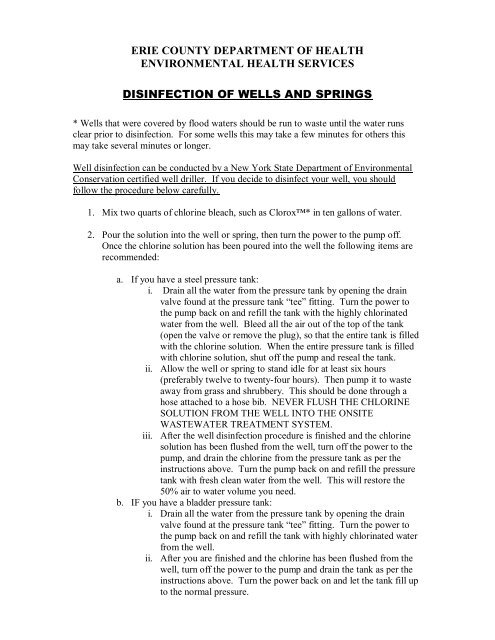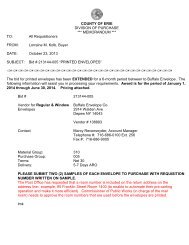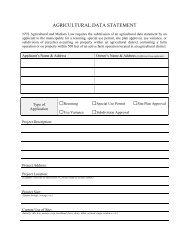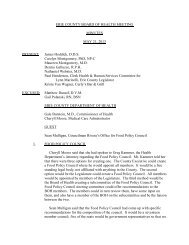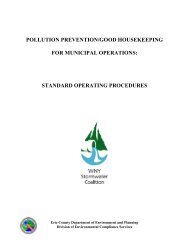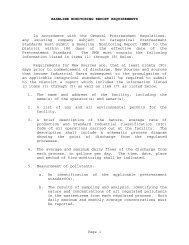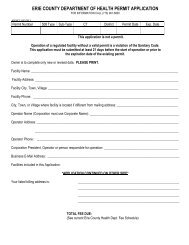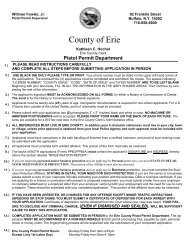well disinfection procedures - Erie County
well disinfection procedures - Erie County
well disinfection procedures - Erie County
You also want an ePaper? Increase the reach of your titles
YUMPU automatically turns print PDFs into web optimized ePapers that Google loves.
ERIE COUNTY DEPARTMENT OF HEALTHENVIRONMENTAL HEALTH SERVICESDISINFECTION OF WELLS AND SPRINGS* Wells that were covered by flood waters should be run to waste until the water runsclear prior to <strong>disinfection</strong>. For some <strong>well</strong>s this may take a few minutes for others thismay take several minutes or longer.Well <strong>disinfection</strong> can be conducted by a New York State Department of EnvironmentalConservation certified <strong>well</strong> driller. If you decide to disinfect your <strong>well</strong>, you shouldfollow the procedure below carefully.1. Mix two quarts of chlorine bleach, such as Clorox* in ten gallons of water.2. Pour the solution into the <strong>well</strong> or spring, then turn the power to the pump off.Once the chlorine solution has been poured into the <strong>well</strong> the following items arerecommended:a. If you have a steel pressure tank:i. Drain all the water from the pressure tank by opening the drainvalve found at the pressure tank “tee” fitting. Turn the power tothe pump back on and refill the tank with the highly chlorinatedwater from the <strong>well</strong>. Bleed all the air out of the top of the tank(open the valve or remove the plug), so that the entire tank is filledwith the chlorine solution. When the entire pressure tank is filledwith chlorine solution, shut off the pump and reseal the tank.ii. Allow the <strong>well</strong> or spring to stand idle for at least six hours(preferably twelve to twenty-four hours). Then pump it to wasteaway from grass and shrubbery. This should be done through ahose attached to a hose bib. NEVER FLUSH THE CHLORINESOLUTION FROM THE WELL INTO THE ONSITEWASTEWATER TREATMENT SYSTEM.iii. After the <strong>well</strong> <strong>disinfection</strong> procedure is finished and the chlorinesolution has been flushed from the <strong>well</strong>, turn off the power to thepump, and drain the chlorine from the pressure tank as per theinstructions above. Turn the pump back on and refill the pressuretank with fresh clean water from the <strong>well</strong>. This will restore the50% air to water volume you need.b. IF you have a bladder pressure tank:i. Drain all the water from the pressure tank by opening the drainvalve found at the pressure tank “tee” fitting. Turn the power tothe pump back on and refill the tank with highly chlorinated waterfrom the <strong>well</strong>.ii. After you are finished and the chlorine has been flushed from the<strong>well</strong>, turn off the power to the pump and drain the tank as per theinstructions above. Turn the power back on and let the tank fill upto the normal pressure.
c. Bypass all water treatment units.i. Cartridge filter: Remove the filter cartridge and put the unit backtogether and disinfect the housing. Replace the cartridge with anew one once the chlorine has been flushed from the system.ii. Water Softeners: Disinfect the water softener either just before orimmediately after the water system has been disinfected. Todisinfect the softener add ¼ to ½ cup of bleach to the small filltube in the large brine tank and do a manual recharge (if you areunsure how to do this, please contact your water treatmentequipment supplier).d. Hot water tanks:i. While the power to the pump is off and you are draining thepressure tank, if you can, turn off the heater and drain and flush thesediment from the hot water tank.ii. Bring the highly chlorinated water from the <strong>well</strong> into the waterheater.iii. After the chlorine has been flushed from the <strong>well</strong> and while youare draining the pressure tank, turn off and drain the chlorinesolution from the hot water tank. Refill the water heater with freshwater and turn it back on.3. Mix two more quarts of bleach in ten gallons of water and pour this chlorinesolution into the <strong>well</strong> or spring.4. Pour the solution into the <strong>well</strong> or spring while it is being pumped. Keep pumpinguntil chlorine odor appears at all taps. Then close the taps and stop the pump.5. Allow the water system to stand idle for at least six hours (preferably twelve totwenty-four hours). Then flush the system to waste, away from grass andshrubbery. Flush through a hose attached to an outdoor hose bib until the chlorineodor is no longer detectable. NEVER FLUSH THE CHLORINE SOLUTIONFROM THE WELL INTO THE ONSITE WASTEWATER TREATMENTSYSTEM. After flushing from a hose bib, you should then flush the remainingtaps in the house until the chlorine odor is no longer detectable.*Chlorox and other bleaches containing 5 ¼% available chlorine can be purchased inmost drug stores, grocery stores and supermarkets.NOTE: This procedure is to remove bacteriological contamination in the <strong>well</strong> casingand/or piping in the house; the <strong>disinfection</strong> procedure is no assurance that the waterentering the <strong>well</strong> or spring is free of pollution.If further information is needed, please call the <strong>Erie</strong> <strong>County</strong> Department of Health at(716) 961-6800.


